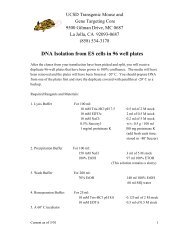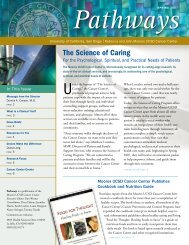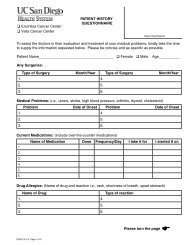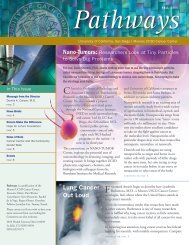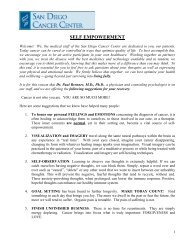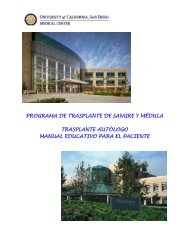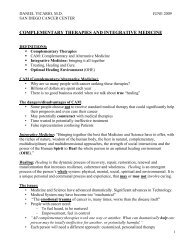university of california, san diego histology shared resources
university of california, san diego histology shared resources
university of california, san diego histology shared resources
You also want an ePaper? Increase the reach of your titles
YUMPU automatically turns print PDFs into web optimized ePapers that Google loves.
Dissection Protocol<br />
Equipment and Materials:<br />
Styr<strong>of</strong>oam board or cork cutting board and pins, flat for cutting<br />
Scissors, delicate ½”—Fisher Cat. No. 08-951-5<br />
Bell jar with lid<br />
200ul Pipetman and pipets<br />
Kimwipes, Lab liners, paper towels<br />
Forceps, curved—VWR Cat. No. 25714-007<br />
Secureline Marker—Fisher Cat. No. 14-905-30<br />
1ml syringe—Fisher Cat. No.<br />
Vacutainer 23G ¾ --Fisher Cat. No.0266539<br />
HistoPrep Tissue Capsules—Fisher Cat. No. 15-182-219<br />
Peristaltic Pump<br />
Phosphate Buffered Saline<br />
Is<strong>of</strong>lurane—MWI Cat. No. 012497<br />
10% Neutral buffered formalin (Buffered Formaldefresh)--Fisher Cat. No. SF93-4<br />
labeled specimen cups<br />
Personal protective equipment eg. lab coat, gloves, eye protection.<br />
Check out this website: www.eulep.org for photographs and other details<br />
Before Autopsy:<br />
1. Determine which organs will be harvested and formalin fixed or frozen.<br />
2. Gather materials and label all necessary cassettes or capsules (see Blocking Chart Protocol.)<br />
3. Record the identifying data on each animal including its appearance and behavior.<br />
4. Record the weight <strong>of</strong> the animal, the individual organs, any abnormal gross pathology, and the<br />
carcass after the organs are removed. (Relative organ weights can be found on page_____.) If<br />
skeletal defects are suspected save the carcass and obtain a radiograph <strong>of</strong> the skeleton. The carcass<br />
may be “cleared” using potassium hydroxide and stained with Alizarin Red and Alcian Blue,<br />
following established protocols.<br />
5. Anesthetize and euthanize animals humanely according to animal welfare guidelines.<br />
6. Wet the animals' fur with 70% ethanol to minimize contamination with hair and lay upon a clean<br />
paper towel. Pin extremities to styr<strong>of</strong>oam or cork board. Dedicated scissors are recommended for<br />
cutting skin and bone.<br />
7. Start from the abdomen and make and a Y-shaped incision should be made to open up the thorax<br />
and abdomen. The ribcage should be opened bilaterally, exposing the underling thymus, heart and<br />
lungs.<br />
8. If the plan is to perfuse the entire animal, canulate the left ventricle <strong>of</strong> the heart with the catheter<br />
connected to the peristaltic pump and secure the catheter with alligator clips..<br />
9. Make an incision in the right atrium to allow the circulating fluids to exit the right atrium.<br />
10. Pump PBS through the circulatory system, using a peristaltic pump. This will flush out blood.<br />
Adequate perfusion is indicated when the liver and kidneys become pale.<br />
11. Follow the PBS flush with freshly made 4% paraformaldehyde for 15 min.<br />
12. Just before finishing the perfusion, insert a formalin filled syringe into the trachea just above the<br />
lungs until full. Then tie <strong>of</strong>f the trachea to keep the fixative in the alveoli<br />
13. Once perfusion is complete, remove the organs listed below in the order listed. This will ensure<br />
that all the necessary structures are collected.





